
管理员获得所有权
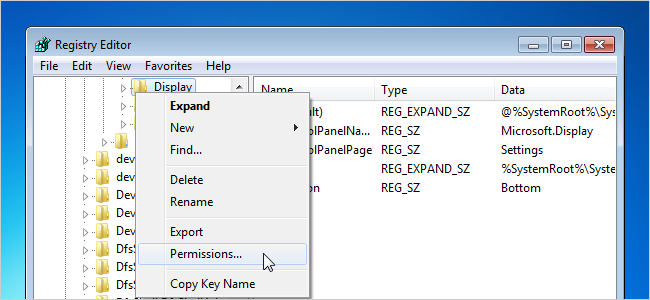
We have previously written about how to take ownership of files and folders in Windows 7, but there may be times when you need to take ownership of or assign full permission for certain registry keys. This article shows you how to do this.
先前我们已经写过关于如何在Windows 7中获得文件和文件夹所有权的信息,但是有时您可能需要获得某些注册表项的所有权或为其分配完全权限。 本文介绍了如何执行此操作。
NOTE: Before making changes to the registry, be sure you back up the registry. We also recommend creating a restore point you can use to restore your system if something goes wrong.
注意:在更改注册表之前,请确保您备份了注册表。 我们还建议您创建一个还原点,以便在出现问题时用于还原系统。
To take ownership of a registry key, open the registry editor, if it is not already open. Type “regedit” in the Search box on the Start menu and pressing enter when regedit.exe is highlighted in the search results. You can also click on the regedit.exe link to open the registry editor.
要获得注册表项的所有权,请打开注册表编辑器(如果尚未打开)。 在“开始”菜单上的“搜索”框中键入“ regedit”,然后在搜索结果中突出显示regedit.exe时按Enter。 您也可以单击regedit.exe链接打开注册表编辑器。
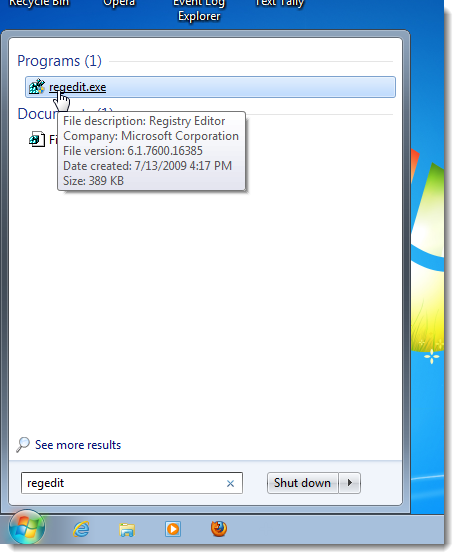
If the User Account Control dialog box displays, click Yes to continue.
如果显示“用户帐户控制”对话框,请单击“是”继续。
NOTE: You may not see this dialog box, depending on your User Account Control settings.
注意:根据您的“用户帐户控制”设置,您可能看不到此对话框。
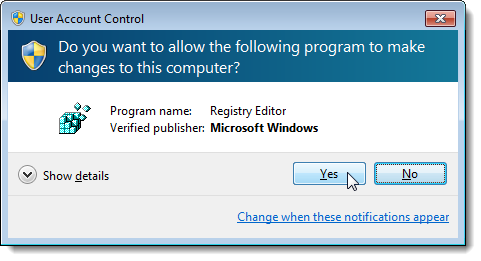
Navigate to the key you want to take ownership of. For this example, we chose the following key:
导航到您要拥有所有权的密钥。 对于此示例,我们选择以下键:
HKEY_CLASSES_ROOT\DesktopBackground\Shell\Display
HKEY_CLASSES_ROOT \ DesktopBackground \ Shell \ Display
Right-click on the desired key and select Permissions from the popup menu.
右键单击所需的键,然后从弹出菜单中选择“权限”。
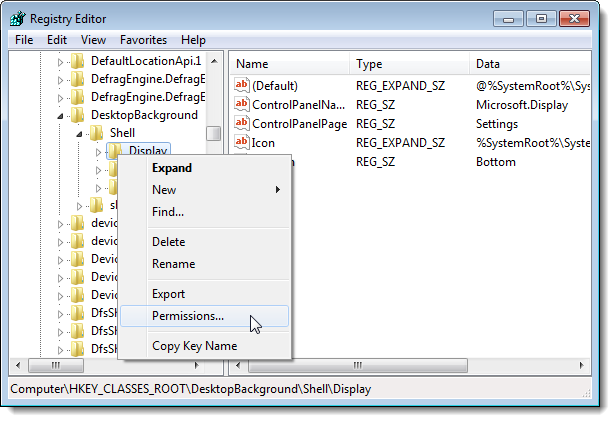
On the Permissions dialog box, click Advanced.
在“权限”对话框中,单击“高级”。
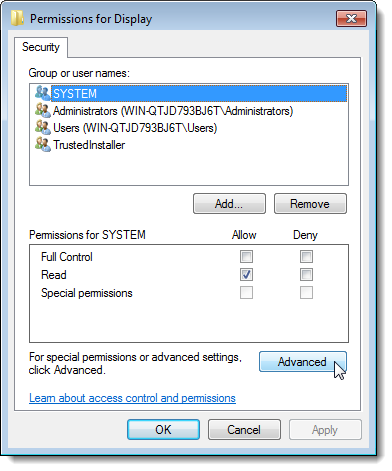
Click the Owner tab on the Advanced Security settings dialog box. Select the owner name in the Change owner to list box. If you want to take ownership of all the subcontainers and objects, select the Replace owner on subcontainers and objects check box.
单击高级安全设置对话框上的所有者选项卡。 在将所有者更改为列表框中选择所有者名称。 如果要拥有所有子容器和对象的所有权,请选中“替换子容器和对象的所有者”复选框。
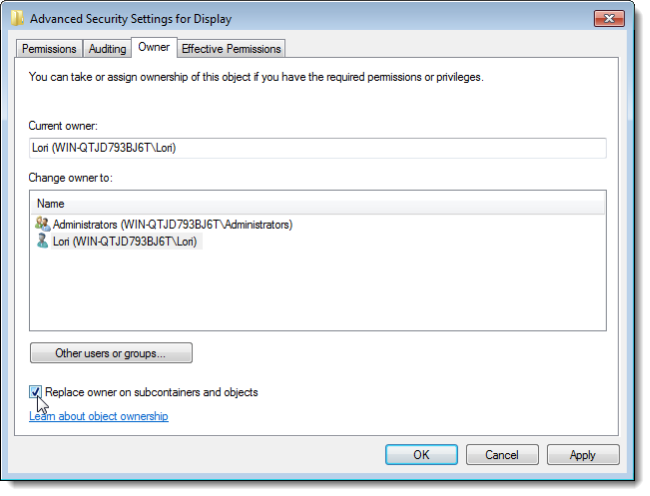
If you want each child object (subkeys) of the selected parent object to have permissions inherited from its parent object, select the Include inheritable permissions from this object’s parent check box. If you want the permissions on the selected parent object to replace those on its descendant objects, select the Replace all child object permissions with inheritable permissions from this object check box. Click Apply to apply your changes.
如果希望所选父对象的每个子对象(子项)都具有从其父对象继承的权限,请选中“包括从该对象的父对象继承的权限”复选框。 如果希望所选父对象的权限替换其后代对象的权限,请选中“使用可继承的对象替换所有子对象权限”复选框。 单击“应用”应用更改。
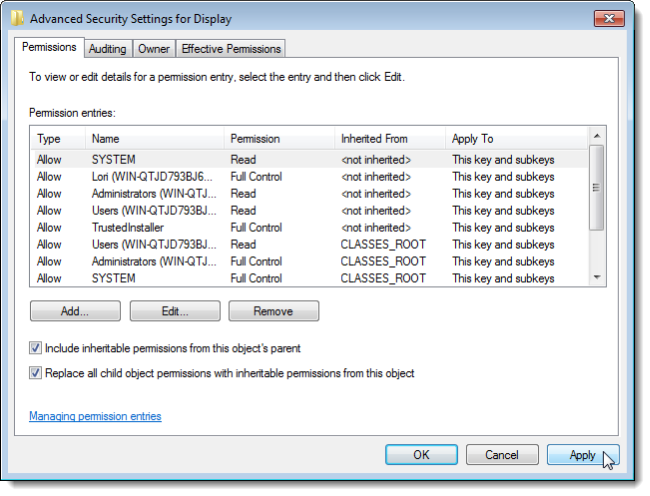
A dialog box displays warning you that all subkeys of the object, in this case the Display key, will inherit permissions from the object. Click Yes if you want to accept this and continue.
将显示一个对话框,警告您该对象的所有子键(在本例中为Display键)将继承该对象的权限。 如果要接受此操作,请单击“是”,然后继续。
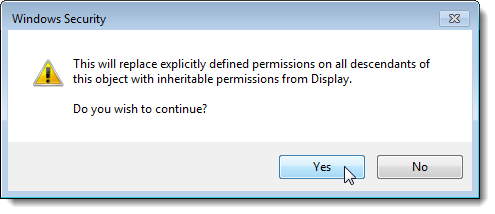
Click OK to close the Advanced Security Settings dialog box.
单击“确定”关闭“高级安全设置”对话框。
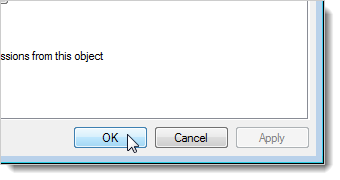
You are returned to the Permissions dialog box. Select the desired user name from the Group or user names list and select the check box under the Allow column for the Full Control row. Click OK.
您将返回到“权限”对话框。 从“组或用户名”列表中选择所需的用户名,然后选中“完全控制”行的“允许”列下的复选框。 单击确定。
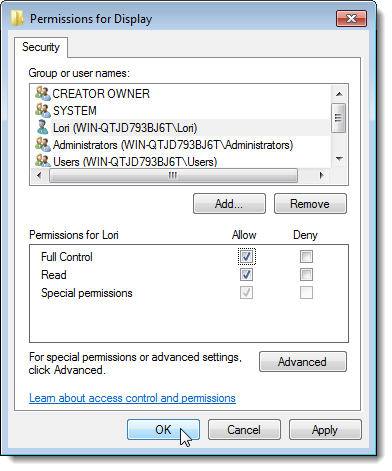
To close the Registry Editor, select Exit from the File menu.
若要关闭注册表编辑器,请从“文件”菜单中选择“退出”。
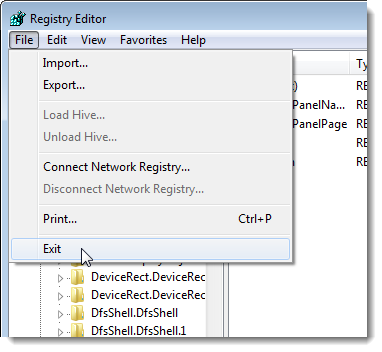
NOTE: Be careful when taking ownership of registry keys and changing them. If you are not sure what you are doing in the registry, it is best not to experiment with changing registry keys.
注意:拥有并更改注册表项的所有权时要小心。 如果不确定在注册表中正在做什么,最好不要尝试更改注册表项。
翻译自: https://www.howtogeek.com/77878/take-ownership-of-or-assign-full-permission-for-a-registry-key-in-windows-7/
管理员获得所有权
 基本框架)











,为什么使用那么多的CPU?...)




绑定)

